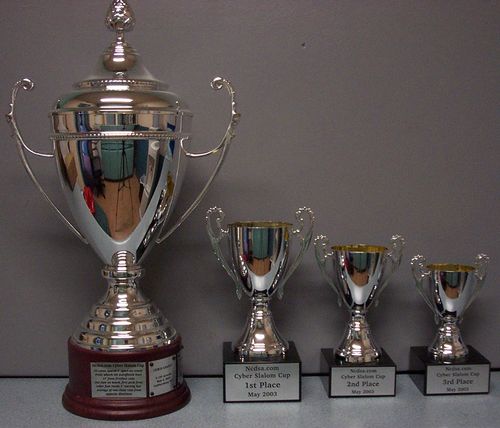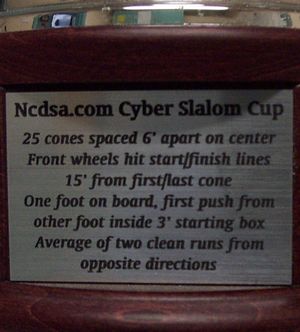
Now in our 29th year! -- 1996-2025

|
|
Northern California Downhill Skateboarding Association
Now in our 29th year! -- 1996-2025 Cyber Slalom Cup Hall of Fame |
|
The Ncdsa.com Cyber Slalom Cup was established in April 2002 as the real-world counterpart to the successful virtual racing series, the Cyber Slalom Challenge, introduced by Ncdsa the previous year. The Cup events give racers the opportunity to compete against fellow cyber slalomers in a real event with everyone competing on the same course, on the same day, with the same timing system, in an officially sanctioned and recorded event. Gone are the virtual vagaries of course differences, self-timing methods, and unverified times; the Cup is real racing. And it wouldn't be the Cup,without, you guessed it, a cup! The actual cup is a two-foot tall perpetual trophy that is presented to the winner at the conclusion of each race and then displayed at the Skatelab Museum in Simi Valley, California between races. Each winner's name is permanently engraved on the trophy. Cup races are held periodically, usually in conjunction with another slalom event to take advantage of the assemblage of slalom racers. In addition, starting in 2003 there are take-home trophies for 1st, 2nd, and 3rd place! 

The rules are the same as the Web-centered Challenge event; namely a twenty-five cone course set in a straight line with cones spaced six-feet apart. Racers start from a dead stop 15-feet from the first cone and are allowed to push their board up to speed to enter the course. Fifteen feet after the last cone is the finish line, with runs usually clocking in the 8-12 second range. The rules allow each racer to take as many runs as possible during the event, which usually runs for 2-3 hours. Racers then choose their best two times (one from each direction of travel) and average them together to get their final score. Only clean runs count, i.e. any downed cones DQ's that run. The Cup event is meant to highlight the specific skills of pumping for acceleration and rapid maneuverability in the course. Pumping, sometimes called gyrating, is a special technique where a rider causes his board to accelerate via a complex set of body-twisting motions. Using this difficult-to-master technique, racers often double -- and can even triple -- their speed over the 144-foot coned section of the course without ever touching foot to ground. Now the fun part.. Since the push-start is limited to the first 15 feet of the course (most people get in 2 pushes, a few 3) racers must generate most of their speed from pumping their skateboard through the line of cones. But don't discount the importance of a strong start, without which you'll never have a chance at fast time. And don't enter the course too hot because those first three cones are so easy to topple when you're trying to find your footing after blasting off the starting line. So, in conclusion, would-be participants would do well to not be fooled by the flat racing surface or the simplistic course. Winning the Cyber Slalom Cup demands a balance of power, endurance, and technique.
The Ncdsa.com Cyber Slalom
Challenge began in May 2001 as a way for geographically disparate
slalom skateboarding enthusiasts to compete with each other in cyber
space. The premise of the Challenge is simple: Maneuver your
skateboard through a standard 25-cone slalom course as fast as
possible without knocking over any cones. Time your results and post
them on Ncdsa.com for others to see and compete against. Each rider is
able to post, and later update, his personal-best time via an input
screen on Ncdsa.com's Cyber Slalom Challenge page. |
||||||||||||||||||||||||||||||||||||||||||
|
Return to Menu
© Copyright 1996-2025 NCDSA - All Rights Reserved |